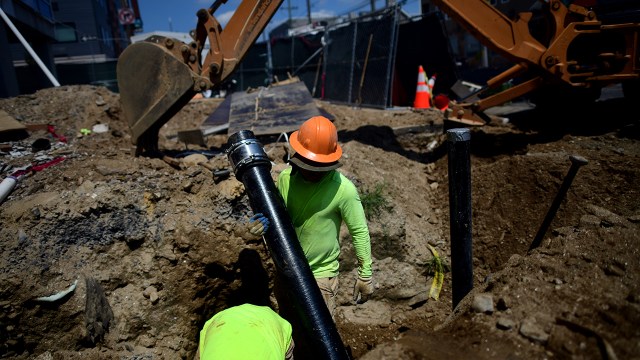
Blue-collar workers have been at or near the center of much public discussion in recent years, from their political leanings to their wages and cultural impact.
A recent Pew Research Center survey finds that these workers – who, by our definition, make up about 27% of the U.S. workforce – stand out from other employed Americans in several ways when it comes to how they see their jobs.
Blue-collar workers are markedly less satisfied with their jobs than other workers. They feel less respected, are less attached to their jobs, and are more likely to view their jobs as just a way to get by, rather than as a career. Younger blue-collar workers and women in blue-collar jobs are especially likely to hold these views.
This analysis takes a closer look at how blue-collar workers see various aspects of their jobs, including how they assess the importance of certain skills and their own opportunities for further training.
Our definition of “blue-collar workers” includes people who do manual or physical labor in their jobs and work in one of five specific industrial sectors: manufacturing, mining and construction; agriculture, forestry, fishing and hunting; retail and trade; hospitality or service; and transportation.
All of our findings are based on a survey conducted Oct. 7-13, 2024, among 5,273 employed U.S. adults, including 1,004 workers we classified as blue-collar. (For more about the survey and how we defined blue-collar workers, read “How we did this.”)
Related: Most Americans Feel Good About Their Job Security but Not Their Pay
Overall job satisfaction
A fundamental difference between blue-collar workers and other workers is how much personal satisfaction they get from work.
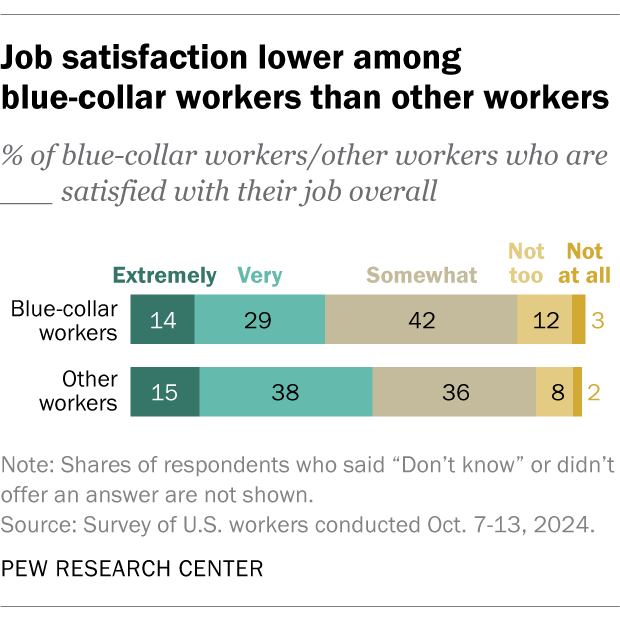
Among blue-collar workers, 43% say they feel extremely or very satisfied with their jobs; by comparison, 53% of other workers express this level of satisfaction. And 15% of blue-collar workers are not too or not at all satisfied, compared with 10% of other workers.
However, slightly more than half of blue-collar workers ages 50 and older (56%) say they’re extremely or very satisfied with their jobs – considerably higher than the share among younger blue-collar workers. In particular, 32% of older blue-collar workers are extremely or very satisfied with their pay, while younger blue-collar workers are less likely to feel this way.
Satisfaction with pay, other aspects of work
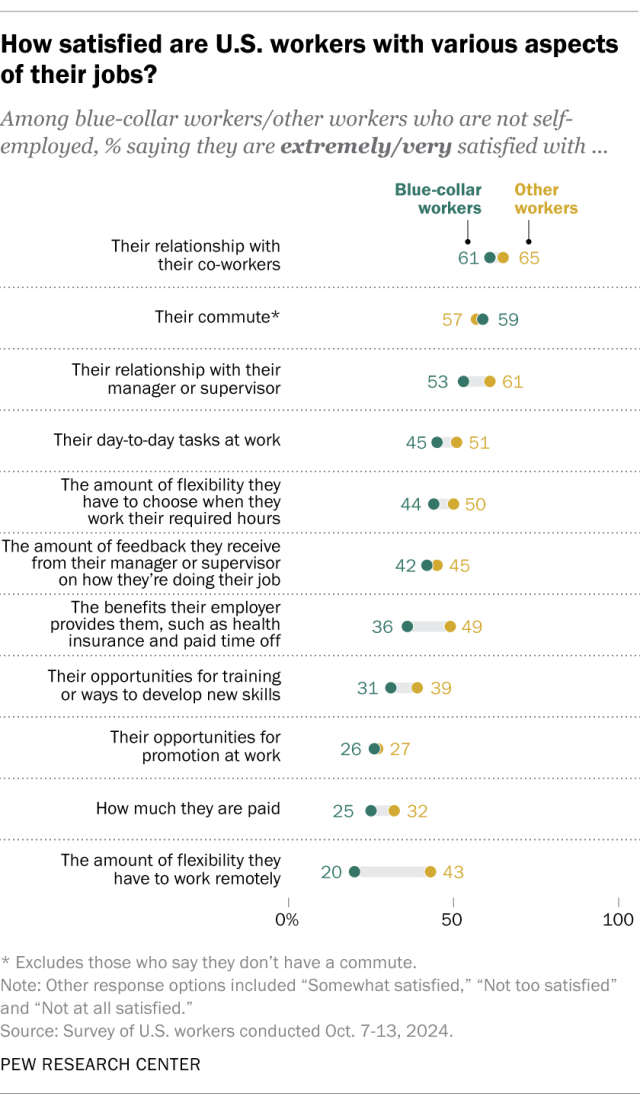
While pay is just one of many things that influence overall job satisfaction, it’s a key factor. Among all blue-collar workers, just a quarter say they’re extremely or very satisfied with how much they’re paid, while a third are not too or not at all satisfied. Among other workers, 32% are extremely or very satisfied with their pay, while 28% are not too or not at all satisfied.
Dissatisfaction with pay is particularly common among women in blue-collar jobs: 40% say they’re not too or not at all satisfied with their pay, compared with 30% of men in these jobs.
We also asked workers who aren’t satisfied with their pay why they’re dissatisfied with it:
- About eight-in-ten blue-collar workers and other workers alike (82% and 80%) say a major reason is that their pay is not keeping up with cost-of-living increases.
- 77% of blue-collar workers and 67% of other workers say a major reason is that their pay is too low for the amount of work they do.
- 64% of blue-collar workers and 50% of other workers say a major reason is that they don’t earn enough to pay their bills.
- 30% of blue-collar workers and 28% of other workers say a major reason is that they earn less than co-workers who do similar work. Blue-collar workers with a college degree are especially likely to hold this view: 43% cite this as a major reason they’re dissatisfied with their pay.
Beyond pay, blue-collar workers are less satisfied than other workers with various other aspects of their work lives, from their health insurance and other benefits to the flexibility of their work hours. One exception: Among workers who commute to their jobs, about equal shares of blue-collar and other workers (59% and 57%) are extremely or very satisfied with their commutes.
Job versus career
Given their lower levels of job satisfaction, it may not be surprising that blue-collar workers are much more likely than other workers to see their jobs not as careers but as something that pays the bills.
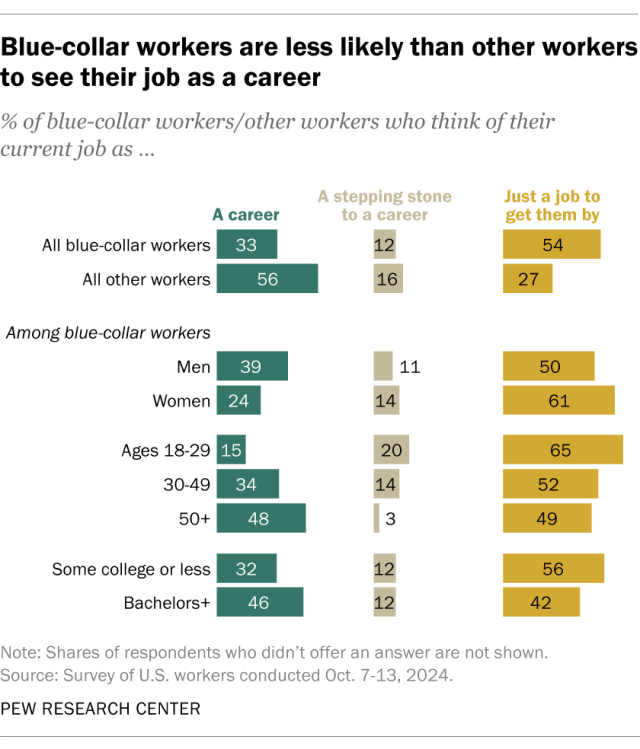
Slightly more than half of blue-collar workers (54%) describe their work as “just a job to get you by” – double the share of other workers who say this (27%). Only a third of blue-collar workers see their jobs as careers, compared with 56% of other workers.
Blue-collar women are especially likely to see their jobs as something just to get them by: 61% describe their jobs this way, versus half of blue-collar men. And while 39% of blue-collar men see their jobs as careers, only around a quarter of blue-collar women (24%) say the same.
Across different age groups, the oldest blue-collar workers are most likely to view their jobs as careers: About half of those ages 50 and older (48%) see their jobs this way. Conversely, 65% of blue-collar workers ages 18 to 29 view their jobs as just something they do to get by.
Relatively few U.S. workers – blue-collar or otherwise – see their jobs as stepping stones to a career. Only 12% of blue-collar workers and 16% of other workers describe their current jobs this way.
Job-hunting
Blue-collar workers are a bit more likely than other workers to say they expect to look for a new job soon.
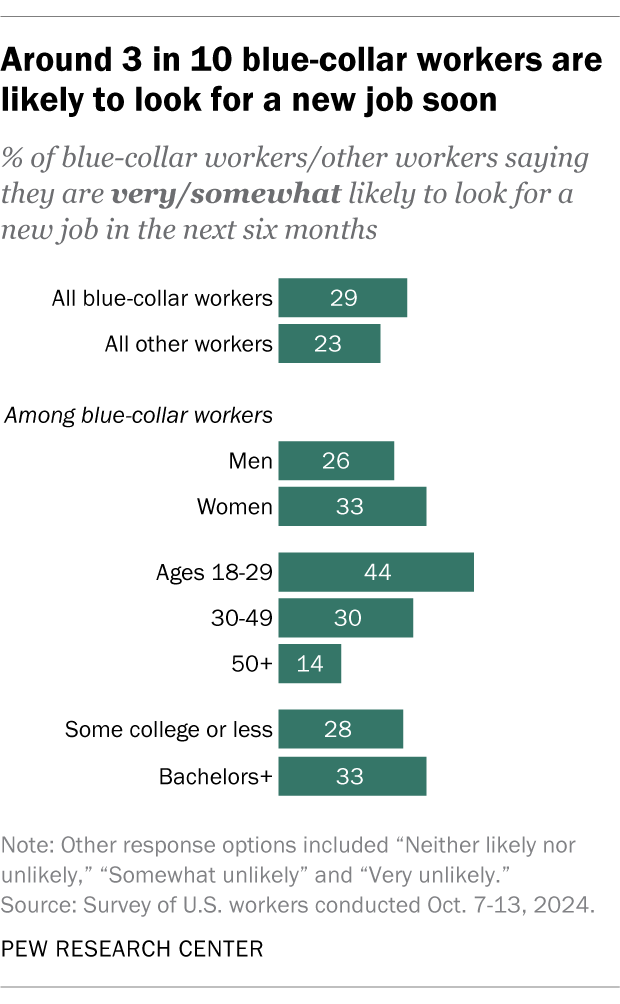
About three-in-ten blue-collar workers (29%) say it’s very or somewhat likely that they’ll look for a new job in the next six months, versus 23% of all other workers. And fewer blue-collar workers than other workers (57% vs. 65%) say it’s somewhat or very unlikely they’ll start looking around soon.
Blue-collar women (33%) and those ages 18 to 29 (44%) are among the subgroups most likely to say they’re very or somewhat likely to look for a new job soon.
While they may be more likely than other workers to look for a new job, blue-collar workers have doubts about finding a position they’ll like. Only 24% say that if they were to look for a new job, finding one to their liking would be very or somewhat easy.
Blue-collar men are a bit more optimistic in this regard than blue-collar women: 28% of men, but just 17% of women, say it would be very or somewhat easy to find the kind of job they want. And the youngest blue-collar workers – those under 30 – are the least optimistic about finding a new job they’d want: Just 11% say it would be very or somewhat easy, while 67% say it would be very or somewhat difficult.
Feeling respected
How respected do blue-collar workers feel by society and at work?
Only around three-in-ten blue-collar workers (31%) say most Americans have a great deal or a fair amount of respect for the work they do, compared with nearly half of other workers (47%). Conversely, 35% of blue-collar workers (including 41% of women) say most Americans don’t respect their work much or at all – a sentiment shared by just 19% of other workers.
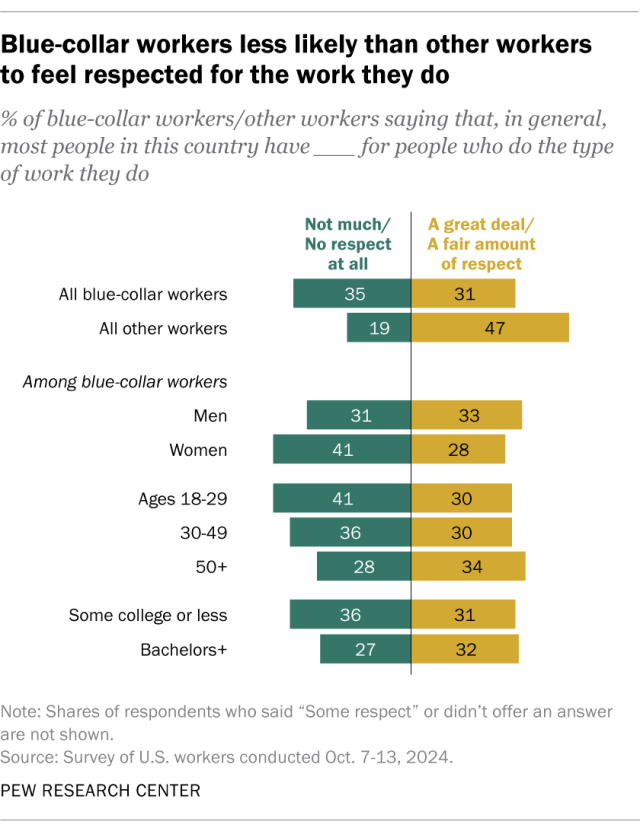
Attitudes are somewhat more positive when it comes to being respected on the job. Most of blue-collar workers (78%) say their supervisor treats them respectfully all or most of the time, though that’s still fewer than the 83% of other workers who say the same. Most blue-collar workers and other workers (83% and 87%) say their co-workers treat them with respect all or most of the time.
Meanwhile, among blue-collar workers who interact with customers or clients, two-thirds (67%) say they’re treated with respect in those relationships all or most of the time, compared with about three-quarters of other workers (74%).
(These figures exclude workers who say they don’t have co-workers, supervisors, or clients or customers.)
Education and training
About three-in-ten blue-collar workers (31%) say they need more education or training to get ahead at work, about the same share as other workers. However, relatively few see more formal schooling as the best source of additional instruction.
Among blue-collar workers who say they need more education or training to get ahead, only 17% say formal education – for example, a high school diploma or college degree – would be the best way to get it, compared with 27% of other workers. About a third (32%) say on-the-job learning would be the best way; 28% say completing a certificate program.
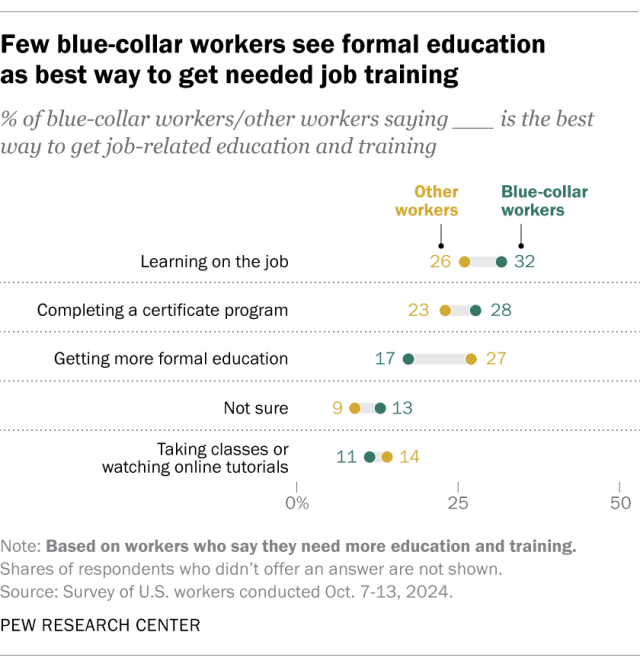
Similar shares of blue-collar men and women (39% and 36%) say they’ve taken a class or received extra training in the past 12 months to learn, maintain or improve job skills. But their motivations for doing so are somewhat different. About two-thirds of blue-collar men who’ve taken a class or received extra training (65%) cite keeping up with requirements in their field or industry as a reason they did it; 52% of their women counterparts say the same. Conversely, blue-collar women who’ve taken classes or received extra training are more likely than men (36% vs. 23%) to cite getting a new job as a reason.
Note: Here are the questions used for this analysis, the topline and the survey methodology.


